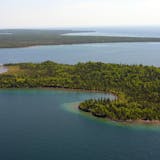Apartments and green spaces, a coffee shop, a golf spot and a brewery. The places popping up along the new Gold Line bus route into the eastern Twin Cities metro reads like a city planner’s development wish list.
The $505 million bus rapid transit (BRT) project is nearly done, with its grand opening just weeks away, and when it comes to development along the route, it seems to be a case of so far, so good.
“We’re pleasantly surprised” to see the amount of investment developers have made, said Oakdale Community Development Director Andrew Gitzlaff.
The Gold Line, opening March 22, is a test case for a different kind of BRT. It’s Metro Transit’s first to run mostly on its own dedicated guideway, allowing buses to bypass traffic along the congested Interstate 94 corridor to serve farther-flung eastern suburbs.
Its opening comes at a tenuous time for transit in the Twin Cities, where Metro Transit may end the Northstar commuter rail and the future of transit funding is uncertain as the Trump administration cuts federal programs. The Metropolitan Council is turning away from costly, time-intensive rail projects and toward BRT. This year alone, the agency will open three BRT routes.
The Gold Line’s 10-mile route is about a 35-minute ride from downtown St. Paul to Woodlane Drive in Woodbury, with stops in Maplewood, Landfall and Oakdale. Buses will run every 10 to 15 minutes for much of the day. In 2027, the line will be extended from St. Paul to downtown Minneapolis.
The Met Council’s light-rail projects drew millions in investment as apartments sprung up along the Blue and Green lines over the past decades, but it wasn’t clear at first if BRT would find similar interest.
Apartments, commercial, industrial along route
Rising seven stories out of what was recently an empty field is the Norhart Oakdale, a 328-unit luxury apartment building. Besides the ground floor coffee shop, rooftop Zen garden and fitness amenities, the building’s website touts proximity to the Gold Line — a stop is outside the front doors.


